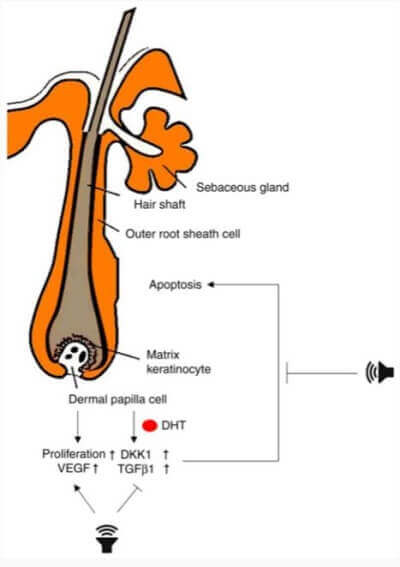I have followed the hair loss world for over 20 years, and written about it on this site for 8.5 years. Nevertheless, almost every single month, I still read something on hair that totally surprises me. The latest is courtesy of this thread on Reddit regarding a new study on the benefits of ultrasound for hair growth.

Inaudible Sound Therapy and Hair Growth
A new study from South Korea that came out last month suggests a role for sound therapy in treating hair loss. It is titled “Induction of hair growth in hair follicle cells and organ cultures upon treatment with 30 kHz frequency inaudible sound.”
According to the authors, these inaudible frequency sound waves positively affect scalp hair via 4-hour treatments that:
- Induce proliferative and anti‑apoptotic effects in human dermal papilla cells (hDPCs) and outer root sheath keratinocytes.
- Inhibit the negative effects of dihydrotestosterone (DHT) upon hair growth.
The authors conclude that:
“Overall, the results suggested that inaudible sound may be effective in treating hair loss and could be used to develop a new hair loss treatment approach.”
They provide two hypotheses on why inaudible sound vibrations are causing hair growth:
- The promotion of hair growth occurs due to activation of the Wnt/β-catenin signaling pathway via the sound waves.
- The hair growth occurs as a result of mechanotransduction (mechanical stress) from the cell membrane of hair follicle cells. This stress is a result of modification by the inaudible sound.
Ultrasound Drug Delivery for Hair Growth
Note that ultrasound therapy and related devices are often used to improve drug delivery systems. In 2020, I discussed a study that used ultrasound activated nanoparticles to treat androgenetic alopecia. Also in the same year, I discussed sonophoresis and radio frequency as new potential ways to deliver topical finasteride.
A 2020 study from Taiwan found dual-frequency ultrasound to be effective for transdermal minoxidil delivery and hair growth enhancement. The authors found that ultrasound-mediated microbubble cavitation significantly increased both skin permeability and transdermal drug delivery.
Molecular Vibrations
This phenomenon is not as unbelievable as one would expect. For many years, we have known that even things like low-level laser light (LLLT) therapy, massage/mechanotherapy, scalp wounding, and even friction can lead to hair growth in some.
And in the way-out-there world, we have read anecdotal reports of hair regrowth on people who got unintentional scalp injuries from fire and even lightening. I think I should hereon call all such phenomena as “molecular scalp vibration” spurred hair growth.
The authors of this latest study cite a number of supporting studies. This includes ones that suggest that low-intensity vibrations and sound impact the body at the cellular and genetic level.